Earth and Moon Infinity Puzzles ™

Explore the Earth and Moon through our mind-bending, never-ending jigsaw puzzles. The Earth Infinity Puzzle is a map of the globe unlike any you’ve seen before. Start anywhere and see where your journey takes you. This puzzle is based on an icosahedral map projection and has the topology of a sphere. This means it has no edges, no North and South, and no fixed shape. Try to get the landmasses together or see how the oceans are connected. Make your own maps of the earth!
The Earth Infinity Puzzle has 442 pieces and costs $120. As a companion, we are also releasing the Moon Infinity Puzzle so you can also explore lunar geography. The Moon Puzzle has 186 pieces and costs $60. Both puzzles use imagery courtesy of NASA, the Earth from the NASA Earth Observatory and the Moon from the Lunar Reconnaissance Orbiter.
Map Projections
A classic map imposes distortions and orientations that reflect our preconceived notions of the world. The Mercator projection, which is the map we are most familiar with, unrolls the globe into a rectangle with even spacing of latitude and longitude, inflating Greenland into a massive tundra and smearing Antarctica into an unrecognizable white smudge at the bottom. It makes it seem like the Arctic is impassably vast, when actually flying over it is the fastest way to get to Europe from the US. More subtly, it reinforces the idea of a world split into West and East. Even a true globe typically has a fixed North-South axis, forcing us into a certain viewpoint.
The Earth puzzle is based on type of map called a polyhedral projection, where the sphere is projected onto a shape with planar faces and then unfolded flat. In this case, the globe is projected onto a icosahedron, a 20 sided shape of equilateral triangles. This reduces the distortion seen in most maps. This type of map was most famously explored by Buckminster Fuller with his Dymaxion Map. However, unlike the Dymaxion Map, our map is equal-area, meaning the relative size of landmasses is preserved exactly.
We created software to turn a Mercator projection into an icosahedral one. This allowed us to transform photographs from NASA’s Earth Observatory and Lunar Reconnaissance Orbiter into our icosahedral mapping. We use a technique called spherical barycentric coordinates to project the sphere onto the icosahedron. These are area coordinates where every point on a triangle is identified as the weighted sum of its 3 vertices. If you take a point in a triangle and use that to subdivide the triangle into three smaller triangles, then the weight associated with each vertex is proportional to the area of the opposite triangle. Barycentric coordinates are commonly used in computer graphics to interpolate quantities on triangular meshes. You can extend this idea to spheres using spherical triangular patches and their areas. By doing so, the same area on the sphere corresponds to a proportional area on the icosahedron. The whole thing works in a GLSL shader. First we draw a triangle and its barycentric coordinates. We use those coordinates to compute a point on the sphere using spherical barycentric coordinates. From that point, we get the latitude and longitude, which allows us to look up the texture of a Mercator map.
We used the tool to design the projection such that the vertices of the icosahedron do not lay on land. The vertices are the only fixed point of the puzzle, and a seam must pass through them in order to make the puzzle flat. By putting the vertices in the ocean, it means all continents can be assembled into continuous shapes.
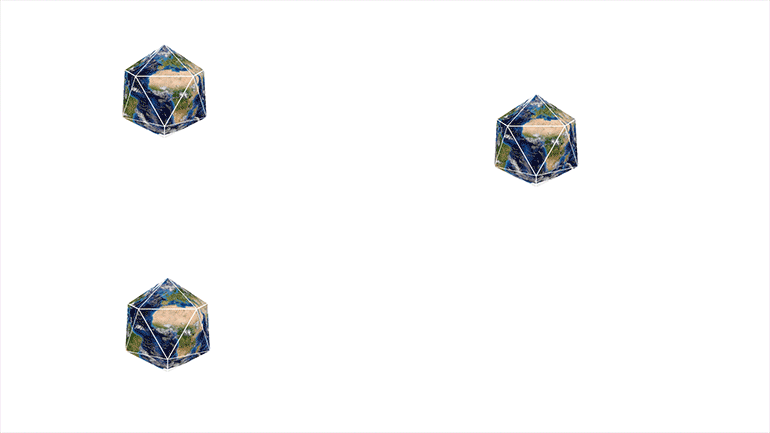
Infinity Puzzle
While Fuller always envisioned his Dymaxion Map as reconfigurable, we take this one step further by making a 442 piece puzzle with no edges. There is no fixed orientation or configuration of the puzzle. Assemble it such that all the continents form an almost continuous land mass or put all the oceans together. Put Antarctica in the center. This extends the Infinity Puzzle concept we first introduced with the Infinite Galaxy Puzzle (which has the topology of a Klein Bottle). The Infinity Puzzles are puzzles that truly have no border: pieces wrap around connecting from one part to another. There is no fixed final shape. The first Infinity Puzzles tile, connecting the left to the right and the top to the bottom. The Earth Puzzle’s pieces have more complex relationships, where pieces rotate 60 degrees to zip the seams of the map in different ways. This demonstrates how the infinity puzzles are not simply tiling puzzles but represent a broader range of possible borderless puzzles.
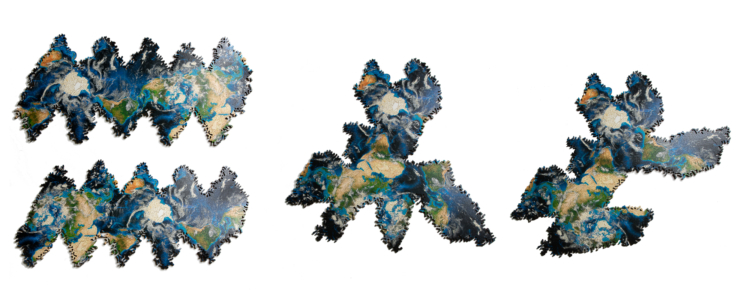
Growing the Puzzle Pieces in 3D
The puzzle pieces we generated for the Earth and Moon puzzles are similar to the maze pieces in our Geode Puzzles. However, there’s a fundamental difference: they had to be grown in 3D on the surface of an icosahedron. To do this, we created a new version of our Maze system which is a simulation of elastic rods. The puzzle piece edges grow, lengthening, until they collide, pushing each other into contorted shapes. Because the puzzle pieces are growing on a 3D surface, we have to unfold them to a flat pattern so they can be turned into a jigsaw puzzle.
Whimsy Pieces
The Earth Infinity Puzzle includes 16 figure pieces shaped like animals indigenous to different parts of the world: a kiwi on New Zealand, an alpaca in South America, a giraffe and rhino in Africa, and different whales and marine animals throughout the ocean.
The Earth and Moon Infinity Puzzles are for sale in our shop now along with our other Infinity Puzzles.

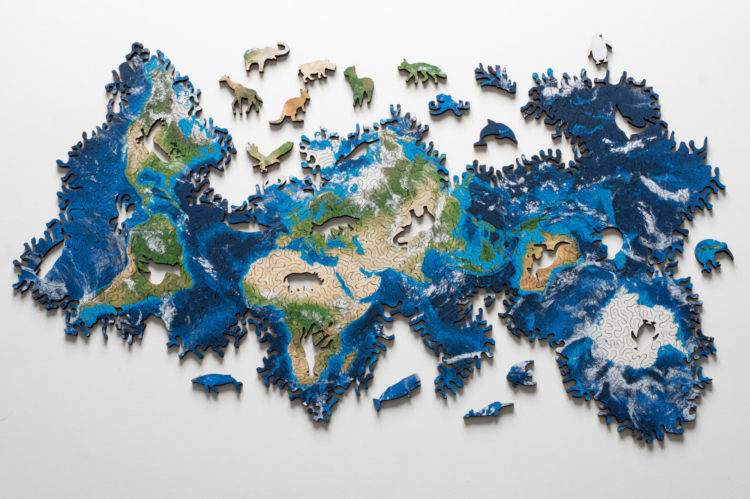
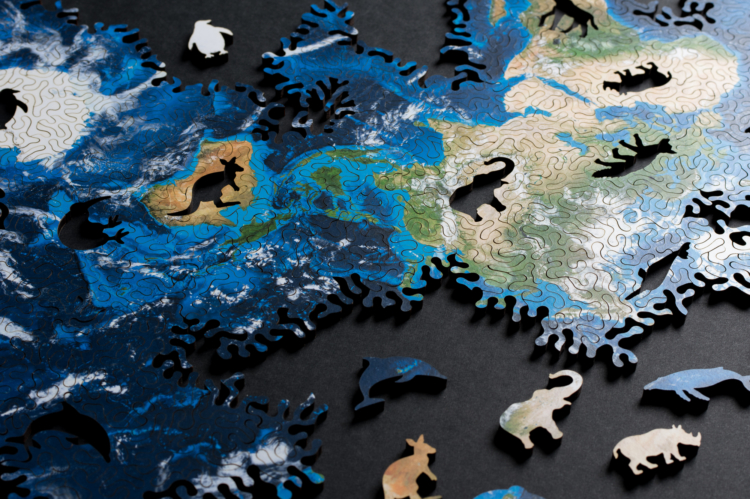

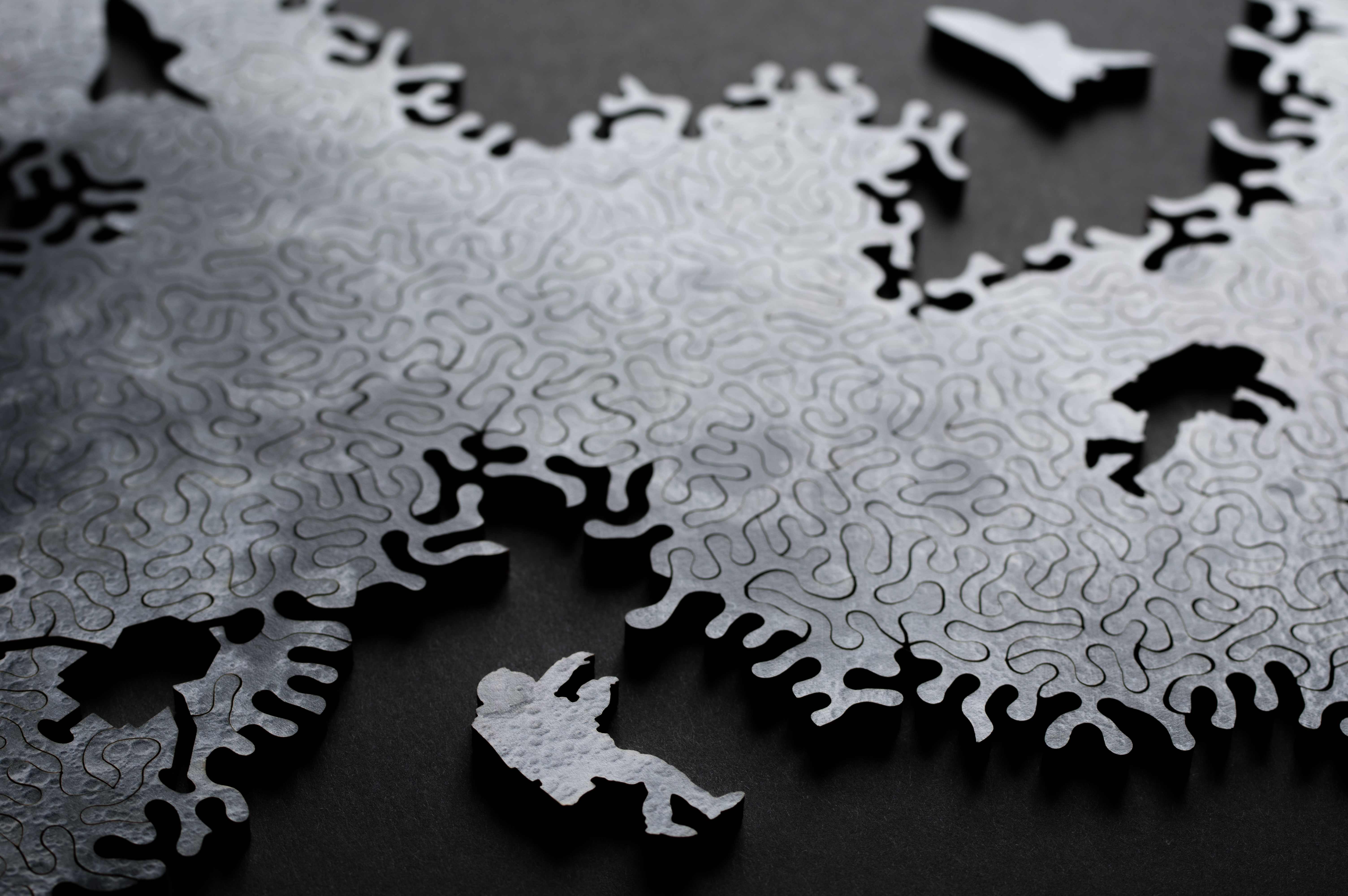
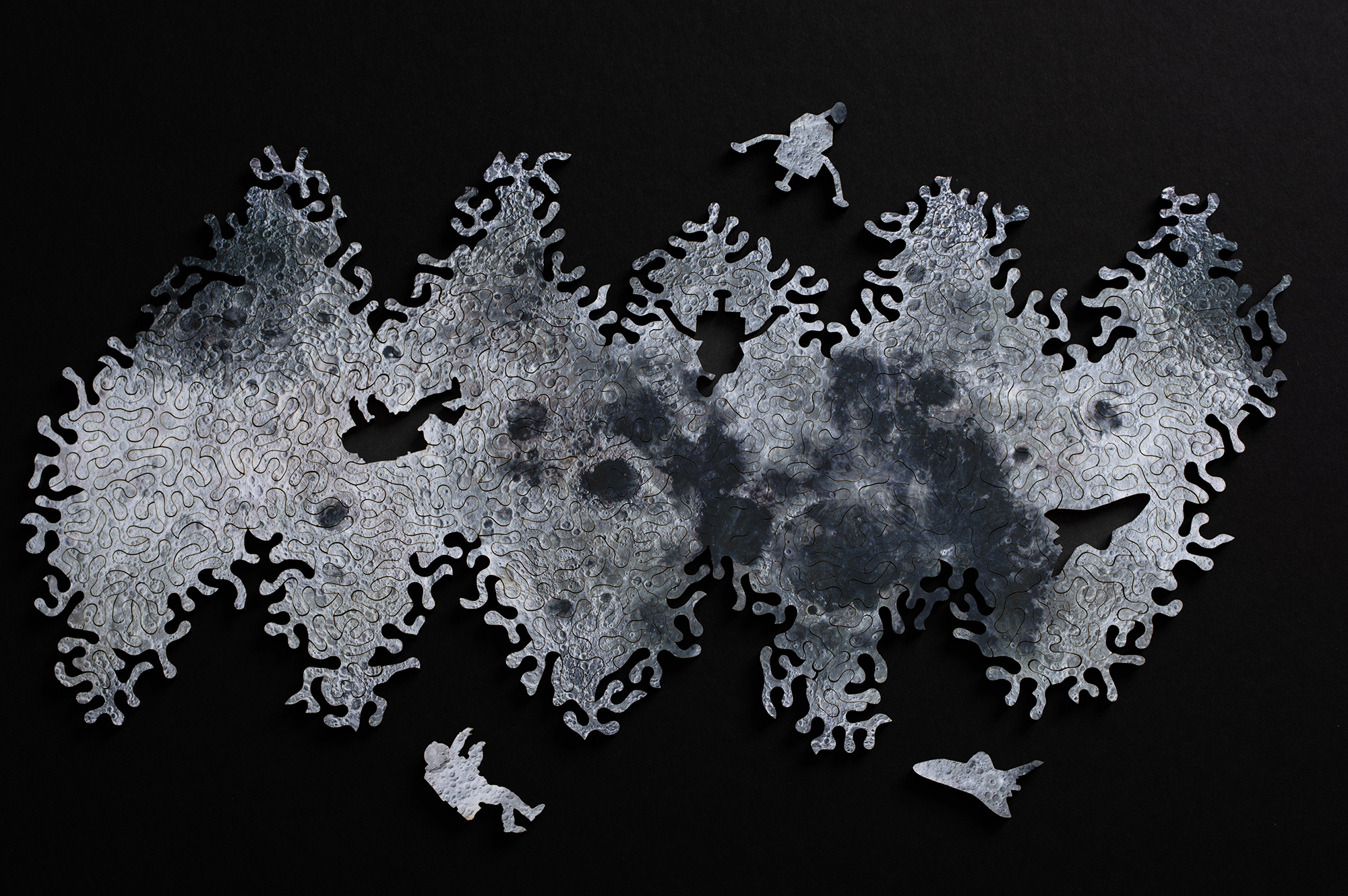
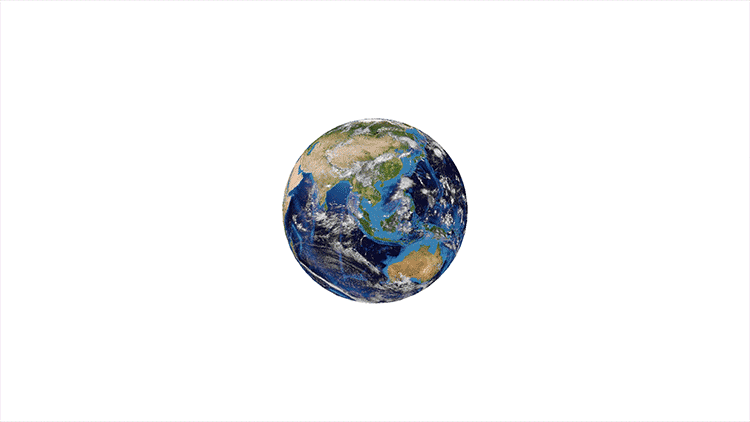
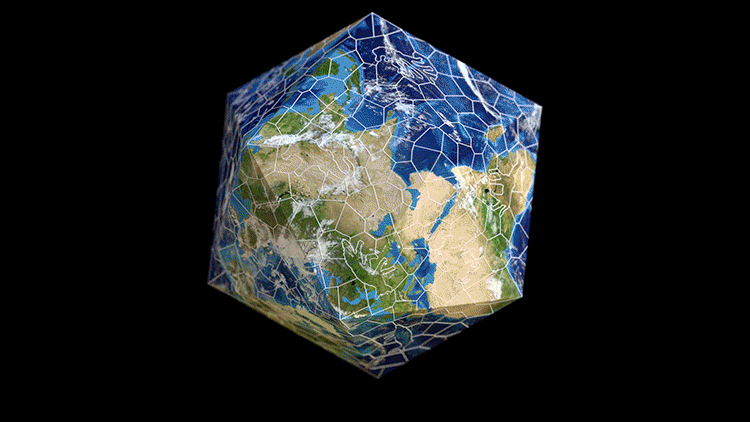
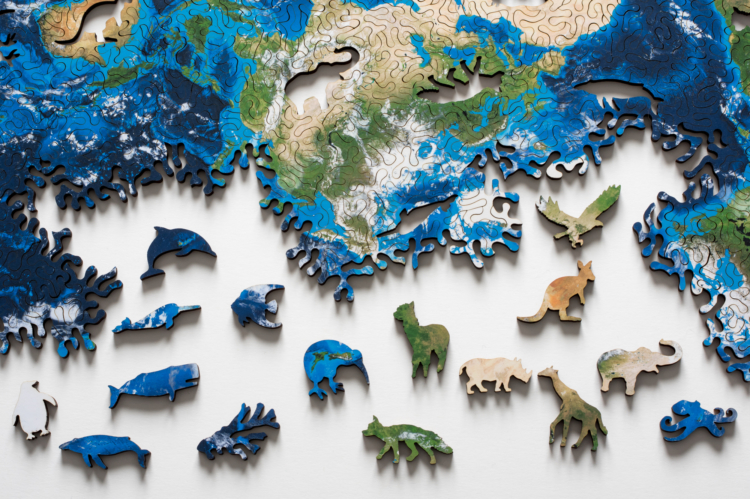



Earth puzzle without borders
[…] The Earth Puzzle by generative design studio Nervous System has no defined borders. You put it together how you want. […]
ZRC
This would be even more wonderful with magnetic pieces, in order to display the map on a wall while still being able to move the pieces and change the overall shape.
Dave
I adore this. Incredibly elegant idea to show how we can break out of our standard 2D map projections.
Any chance you would consider making a version with larger / easier to assemble pieces?
I would *LOVE* to get one of these for my children (3 +/-1 years) but >400 pieces with small details is not realistic. Tipping the balance more towards teaching tool, rather than challenging puzzle, would be just delightful for the parents of young children learning to explore.
Jessica
that’s a great idea and we will definitely consider it.
Dmitri Zdorov
Beautiful, educational and just amazing
Jessica
thanks <3
Geographical christmas – GIS Is It
[…] Link: n-e-r-v-o-u-s.com […]
IC
Ah, too bad this puzzle couldn’t be rented for us folks w/o higher means.
wonderful puzzles!
Jessica
puzzle renting is an interesting idea. what would be a reasonable cost to rent a puzzle?
Seth Behn
Hi, I ordered the puzzle, I love it. Can you tell me the specific NASA image you used, as I would like to print a larger copy of it to use as a guide! Thanks.
Margaret Swanson
Hi Seth,
It’s primarily based this image but we remapped it into an icosahedral projection and incorporated the cloud data. If you email us at orders@nervo.us we can send you something to print out.
Nervous System’s Earth Puzzle is Based on a Polyhedral Projection #ArtTuesday « Adafruit Industries – Makers, hackers, artists, designers and engineers!
[…] cool puzzle from Nervous System via […]
Eliana
Hi, this is the most wonderful puzzle & world map concept I’ve ever seen. There has been centuries-long debate over world map distortions and Mercator map projections, so this is, simply put, genius. Is ot possible to glue or fix the puzzle pieces onto a surface or mount support that can be hung on a wall?
Jessica
While it’s certainly possible to glue the pieces to a backing board and frame it, I think the best aspect is that it is reconfigurable so I would recommend keeping it unglued.
LL
Oh pleeeease, do it with a magnetic layer !!!
We can do it ourself : https://duckduckgo.com/?q=magnet+sheets
But at this price, I think that it would be fair if you add a magnet layer before the laser cutting…
Matt
I hadn’t read this post, I just got the puzzle and started working. My progress was pretty slow shortly after completing all of the land masses–then I had a Eurika moment which caused progress to resume. In that moment I realized how mathematically awesome this puzzle is. Sure, I knew about map projections, but I’ve never had to feel it this way before. Super Cool!
You guys should look into the math behind Escher’s “Print Gallery” and see if you can make a puzzle that shows it off.
Ashley
I’m sure it has been mentioned but I’m obviously blind to it but just wondering what the size/measurement is roughly of the Earth puzzle. Just wondering as I may want to buy a frame that would fit it easily. Cheers p.s loving the ideas of a magnetic backing 😍
Jessica
Hello! The puzzle size will depend on what shape you assemble it into. But in the “standard” configuration it is around 21×10″
MN
Just want to add my voice to the folks asking for this with magnetic backing. This is so interesting and special, I’d love to display it on our wall or fridge AND have it still be reconfigurable as well AND be something my kids look at and toy with just a few pieces at a time (moving pieces around from one spot to another). Is there any chance of a magnetic back happening at some point in the future?
Jessica
Unfortunately we don’t have a way to manufacture puzzles when a magnetic back.